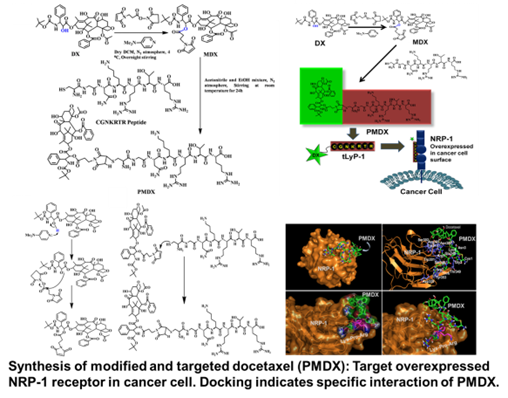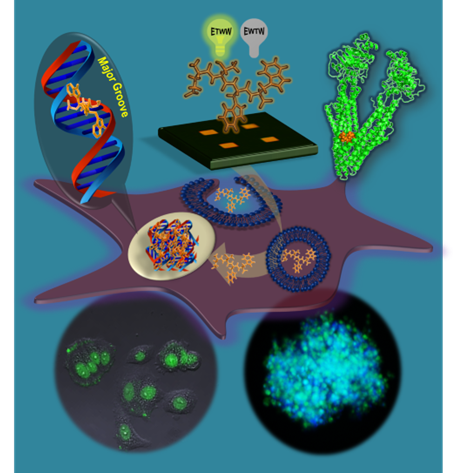Chemical Biology
Home / Chemical Biology
Chemical Biology (Modulator for Microtubule Function, ROS and Stem Cells):
- Combination therapy targeting microtubule and ROS: Nano-carrier & nano-formulation
- Cell Penetrating Peptides
- Microtubule targeted antimitotic peptides, peptoids and small molecules
- Chemical inhibitors for cancer stem cells
Highlight of recent progress in these areas as follows:
- Microtubule dynamics play a crucial role in cancer cell division. Various drugs are developed to target microtubule. Although a few of them show potential in treatment of cancer, but success rate is limited due to their poor bioavailability and lack of specificity. Thus, development of highly bioavailable and target specific anticancer drug is extremely necessary. To address these key issues, here, a combination of approaches such as development of a dodecapeptide-docetaxel nano-assembly targeted to tubulin and MUC1 targeting oligonucleotide aptamer conjugated liposome for delivering peptide-docetaxel nano-assembly into the breast cancer cell has been demonstrated. These studies reveal that the peptide forms nano-assembly and entraps docetaxel drug. Further, the liposomal formulation of peptide-docetaxel exerts synergistic anticancer effect, activates key mitotic check point proteins and inhibits bipolar spindle formation, metastatic cancer cell migration and growth of tumor mimicking 3D multicellular spheroid. Reference: Mohapatra et al., Advance Healthcare Material, 2016.

- Nano drug delivery agent must be potent enough to carry high dose of therapeutics, competent enough in targeting specific cell of interest. Carrying differentially polar therapeutics simultaneously will make them superior in their class. However, it is of enormous challenge to the researchers to find out such a unique nanocarrier and engineer all the above-mentioned features into it. This work describes for the first time that Apoferritin (Apf) can carry high dose of doxorubicin (Dox), docetaxel (Doc) and Dox-Doc simultaneously towards cancer cell specific targeting and enhanced killing compared to free drug without any functionalization or property modulation. Drug loaded Apf specifically bound and consequently internalized into the cancer cells through receptor mediated endocytosis process and release either single or combination of drug to its specific target. Using molecular docking we have checked the binding efficacy of both the drugs. In addition, we have shown that Apf is non-cytotoxic in nature and binds with intracellular tubulin/microtubule. Further we have studied the efficacy of Apf complexes in 3D multicellular tumor spheroid model. References: Ghosh et al., ACS Applied Materials and Interface, 2016.

- We developed microtubule targeted antimitotic peptides from exchangeable GTP/GDP binding pocket of tubulin and shows moderate anticancer activity. These building block has tremendous potential for further design of microtubule targeted anti-cancer drug. References: Bhunia et al., Chemical Communications 2016; Jana et al. Langmuir, 2017.

- We are involved in design and synthesis of small molecules using classical organic synthetic routes. Further, we are also synthesizing various peptides and peptoids targeted to tubulin/microtubule and kinesin 5 (Eg5) for development of anti-cancer therapeutics. Successful lead molecules are in process of evaluation using in vitro assay and in vivo mice model.
One such example of drug modification is described below. Here, we modified the docetaxel by attaching CGNKRTR peptide with docetaxel to target breast cancer cells through NRP1 receptor for enhancing efficacy and reducing whole body toxicity of docetaxel.

- Microtubule targeted peptide vesicle for anti-cancer drug delivery: We have synthesized microtubule targeted peptide nanovesicles through controlled self-assembly of two oppositely charged peptides, which delivers anti cancer drugs. Reference: Biswas et. al., Chemical Communication, 2014; Adak et al. Chem. Commun., 2016, 52, 7549-7552.

- α-Cyclodextrin interacts at vinblastine site of tubulin and delivers curcumin preferentially to the tubulin surface of cancer cell: α-Cyclodextrin specifically interacts with tubulin close to the vinblastine site and inhibits tubulin polymerization. It enters preferentially into the lung cancer cell (A549) and binds with intracellular microtubules through lysosomal pathway. It forms complex with curcumin (CCC), preferentially enters into the A549 cells compared to the normal lung fibroblast cell (WI38), delivers curcumin specifically onto the tubulin surface, causes severe disruption of intracellular microtubules, causes apoptotic death, activates p53, p21 proteins and inhibits 3D spheroid growth of cancer cell. Reference: Jana et al., ACS Applied Materials and Interface, 2016.

- Nanoparticle based delivery of peptide and DNA targeted to microtubule: We have design and synthesized various DNA and peptide conjugated nanoparticles targeted to microtubule for controlling cancer cell proliferation. References: Jana et al., Chemical Communication, 2015. Nair et al., Chemical Communication, 2015; Saha et al., Chemical Communication, 2014; Khanna et al., Dalton Transactions, 2014; Chowdhury et al., MedChemComm., 2014.

- Discovery of new nuclear localizing cell penetrating peptide: Recently, we tried to understand the exact role of a tetrapeptide “Glu-Thr-Trp-Trp” (ETWW) derived from a long CPP “Pep1”. It is a top-down approach to show how spatial positions of two tryptophans regulate the cellular entry and nuclear localization. This leads to the discovery of a short non-toxic tetrapeptides with excellent potential of cell penetration and nuclear localization. Through various experimental techniques, we showed that this CPP enters into the cancer cell following endocytic pathway and binds at major groove of nuclear DNA, where successive tryptophans plays major role. Subsequently, we showed that it is not a P-gp substrate and non-toxic to PC12 derived neurons, suggesting its excellent potential as CPP. Furthermore, its potential as CPP has been validated in stem cell like multi-cellular 3D cell culture (spheroid) and in in vivo mice model. This study provides major fundamental insights about the positional importance of tryptophan and opens new avenues towards development of next generation CPP and major groove specific anticancer drugs. Ref: Bhunia et. al. J. Am. Chem. Soc, 2018, 140, 1697-1714.








